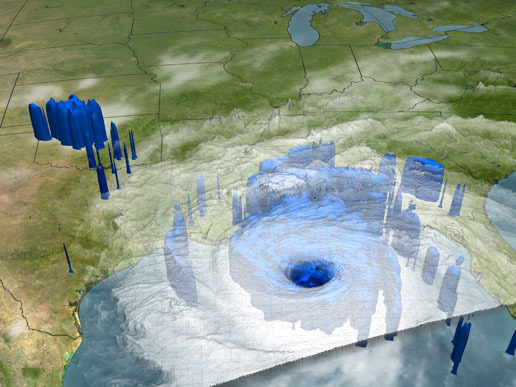NASA's Shuttle External Tank Facility Feels Brunt of Hurricane Katrina

BOULDER,Colorado -- Hurricane Katrina is howling its way through Louisiana and hascaused damage at NASA's Michoud Assembly Facility inNew Orleans, the site where space shuttle external tanks are assembled.
"There iswater leakage and potential water damage in the buildings, but there's no wayto tell how much at this point," Evan McCollum, a Lockheed Martin Space Systemsspokesman in Denver told SPACE.com.

LockheedMartin Space Systems, Michoud Operations operates thesprawling Michoud Assembly Facility for NASA. Whenfully staffed with some 2,000 employees, the organization is one of the largestemployers in New Orleans.
Thefacility features one of the world's biggest manufacturing plants (43 acres underone roof) and a port with deep-water access for the transportation of the largeexternal tanks by barge across the Gulf of Mexico, around Florida and up toKennedy Space Center.
McCollumsaid that a small emergency team - security, facilities, communications peopleand others - are hunkered down in a building at Michoud,riding out the hurricane.
Roofdamage
"Thismorning the winds were about 100 miles per hour at the facility," McCollumsaid. There were some security cameras that have been blown away but some thathad survived. From what they could see from the cameras that had survived, itlooked like there was some roof damage to three or four buildings."
Breaking space news, the latest updates on rocket launches, skywatching events and more!
The Michoud team, McCollum added, is hoping to go out laterthis afternoon when the winds die down to get a visual inspection to see howthings look.
Power fromthe city was lost, with the facility now on backup generators. Pumps wereworking and were appearing to do a good job of handling the deluge of water,McCollum said.
Precautioustaken
"There areseveral external tanks in various stages of production. Precautious were takento guard the tanks from the storm," McCollum said. "They are hoping for a lateafternoon assessment if winds die down to below 50 miles per hour they will goout and do the visual inspection, to check on the tanks and check on thefacilities."
McCollumsaid that, depending on what the emergency team finds later today, the Michoud facility could reopen Thursday, or that may beextended.
"We justdon't know yet," he said.
The832-acre NASA Michoud Assembly Facility is located inNew Orleans, Louisiana some 24 miles (38 kilometers) from New OrleansInternational Airport and 15 miles (24 kilometers) from the French Quarter.
Theexternal tank is 154 feet (46 meters) long, 28 feet (eight meters) in diameterand is the largest single component of the space shuttle system.
The Space ShuttlePropulsion Office at NASA's Marshall Center manages the external tank work.Lockheed Martin Space Systems Company in New Orleans is the primary contractor.

Leonard David is an award-winning space journalist who has been reporting on space activities for more than 50 years. Currently writing as Space.com's Space Insider Columnist among his other projects, Leonard has authored numerous books on space exploration, Mars missions and more, with his latest being "Moon Rush: The New Space Race" published in 2019 by National Geographic. He also wrote "Mars: Our Future on the Red Planet" released in 2016 by National Geographic. Leonard has served as a correspondent for SpaceNews, Scientific American and Aerospace America for the AIAA. He has received many awards, including the first Ordway Award for Sustained Excellence in Spaceflight History in 2015 at the AAS Wernher von Braun Memorial Symposium. You can find out Leonard's latest project at his website and on Twitter.
